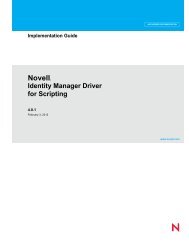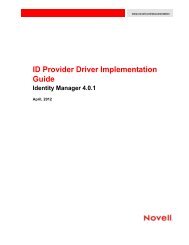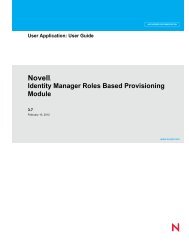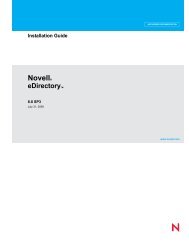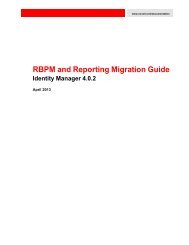Novell LDAP Proxy 1.0 Administration Guide - NetIQ
Novell LDAP Proxy 1.0 Administration Guide - NetIQ
Novell LDAP Proxy 1.0 Administration Guide - NetIQ
Create successful ePaper yourself
Turn your PDF publications into a flip-book with our unique Google optimized e-Paper software.
Example 2<br />
In Example 2, two listeners are defined as listener3 and listener4. Listener3 is defined to use<br />
the ldaps protocol to listen for incoming request on the system. The interface is defined by domain<br />
name server1.example.com and port 636. This node also specifies that a Connection Route policy<br />
identified as admin-policy is to be applied to all requests coming through the specified port, and<br />
also specifies the filename of the certificate to be used by the protocol. Listener4 is defined to use<br />
the ldap protocol, and the interface is defined by domain name server1.example.com and port<br />
389. It also routes requests to a Connection Route policy defined as admin-policy.<br />
3.5 Configuring Additional Back-End Servers<br />
You can configure additional back-end servers for the proxy configuration depending on your needs.<br />
The node in the configuration file lists all the back-end servers<br />
configured for the proxy. The additional back-end servers must be defined in this node.<br />
For instance, assume that you want to define a back-end server, Backend1, to use the <strong>LDAP</strong><br />
protocol. The back-end server listens on IP address 192.168.1.3 and port 389 for incoming requests.<br />
You can define the configuration as follows:<br />
To add a back-end server:<br />
1 Open the nlpconf.xml file from the /etc/opt/novell/ldapproxy/conf directory in any<br />
XML editor.<br />
Manually Configuring <strong>Novell</strong> <strong>LDAP</strong> <strong>Proxy</strong> 29




